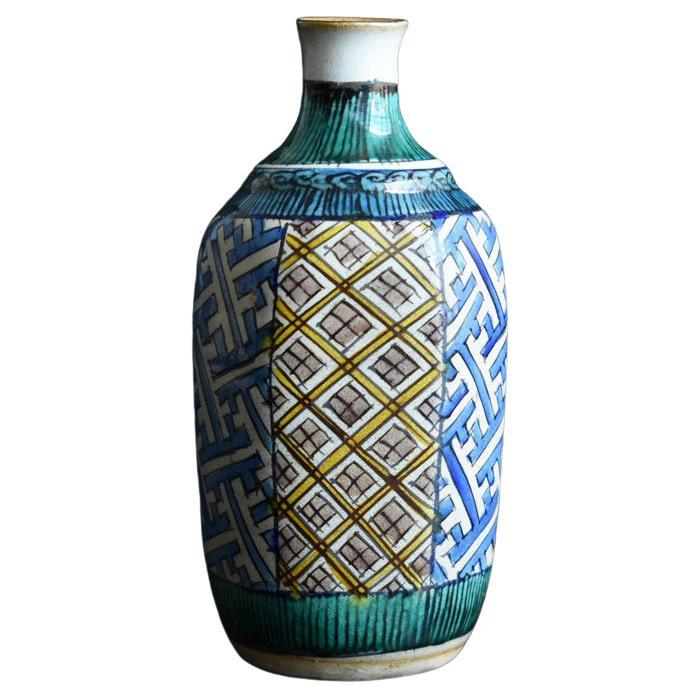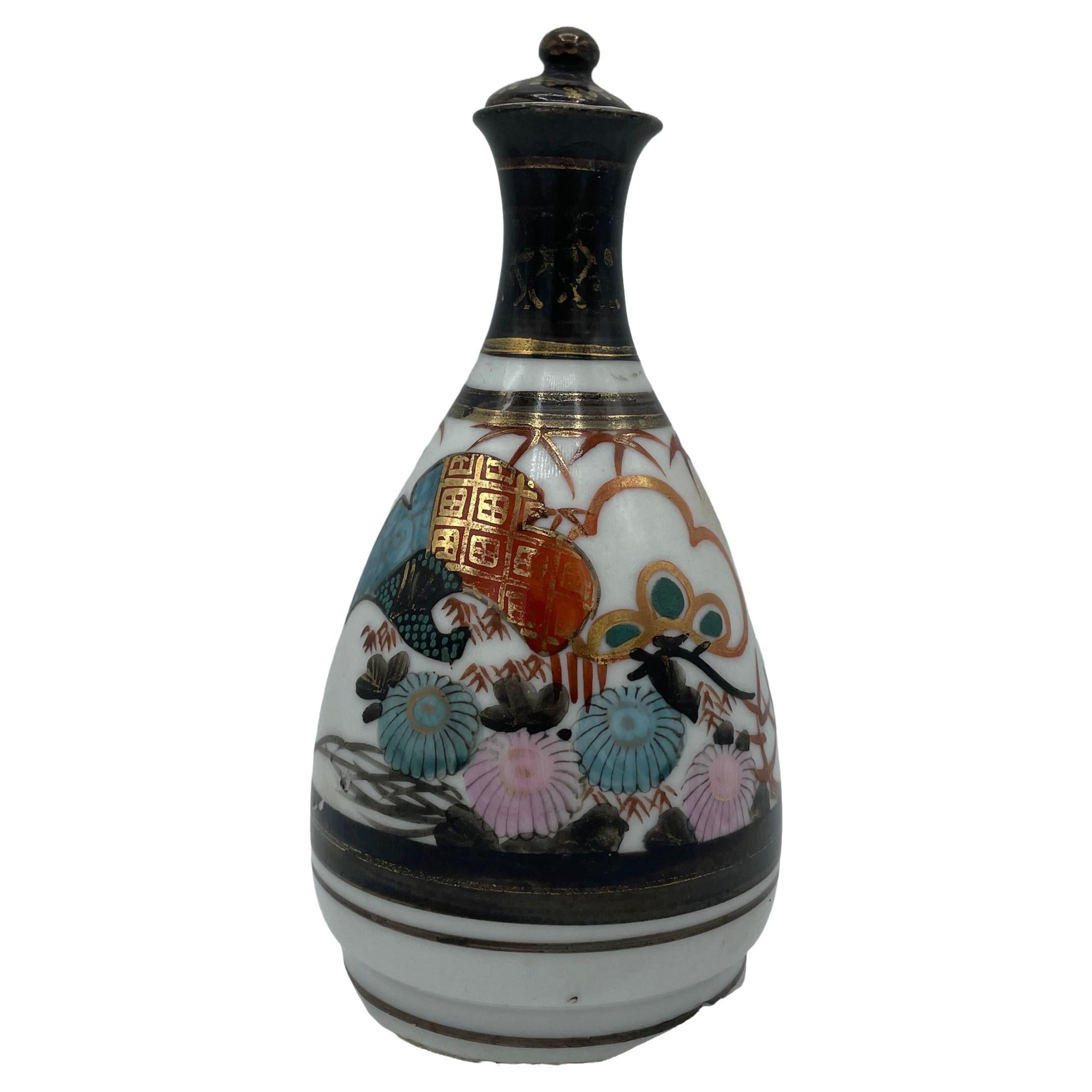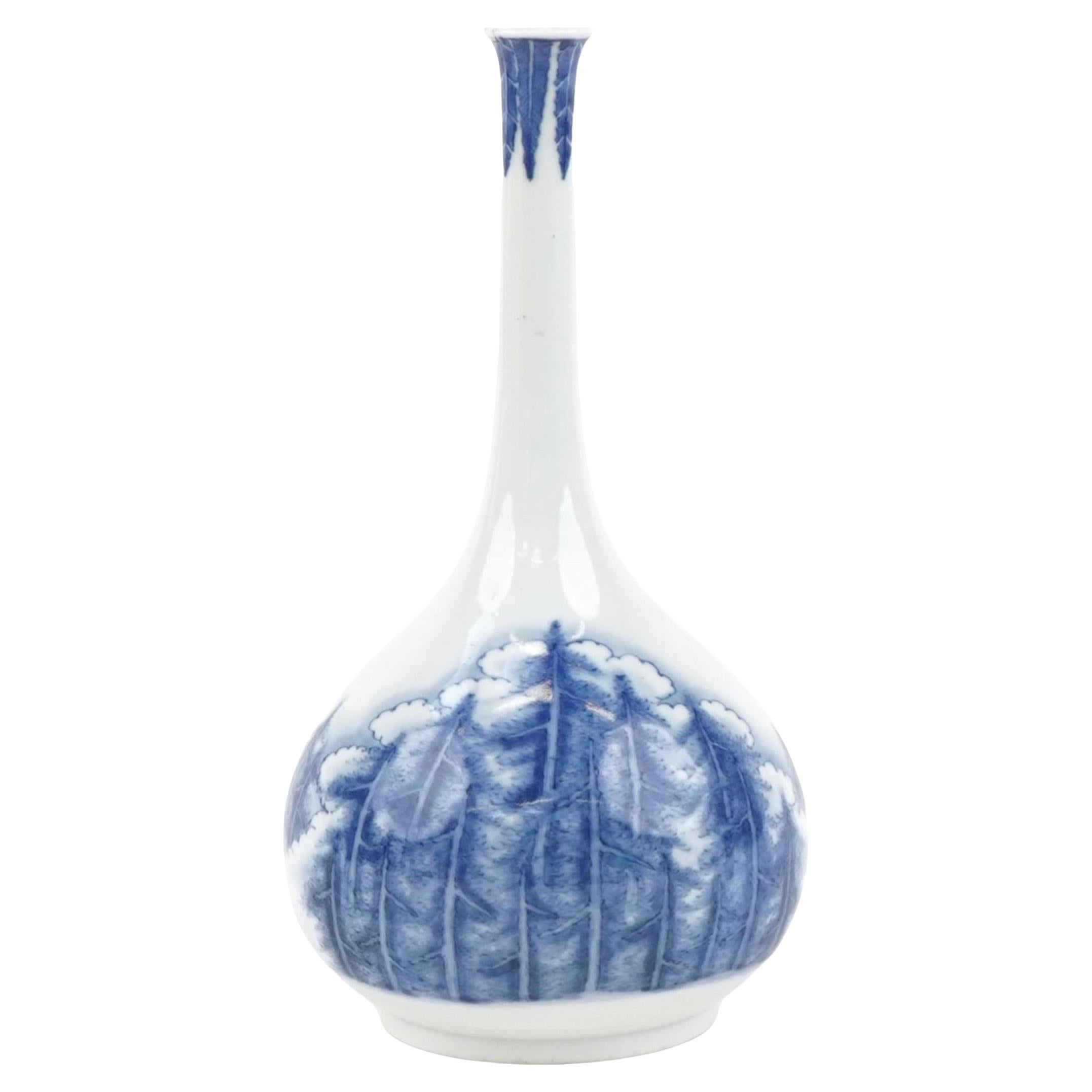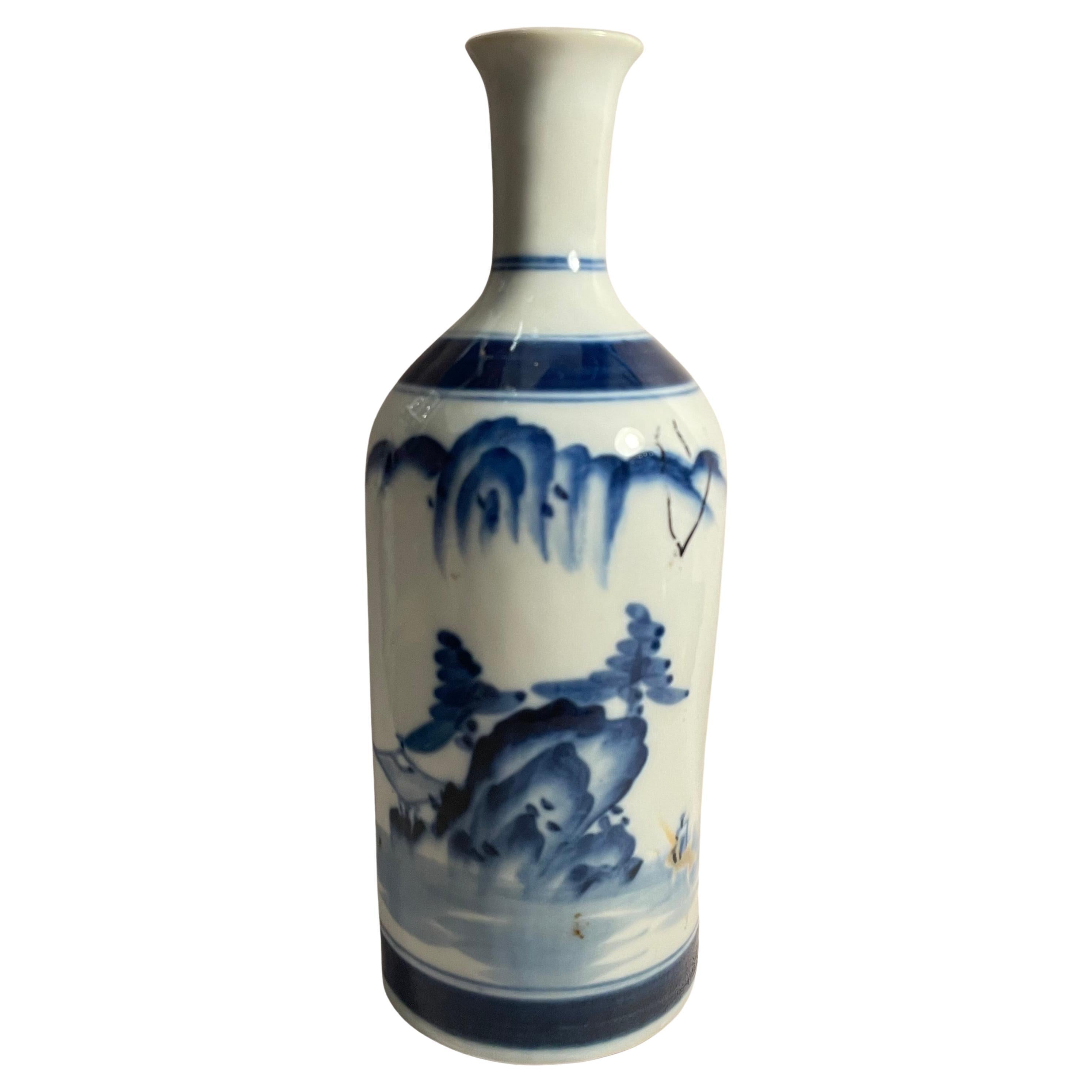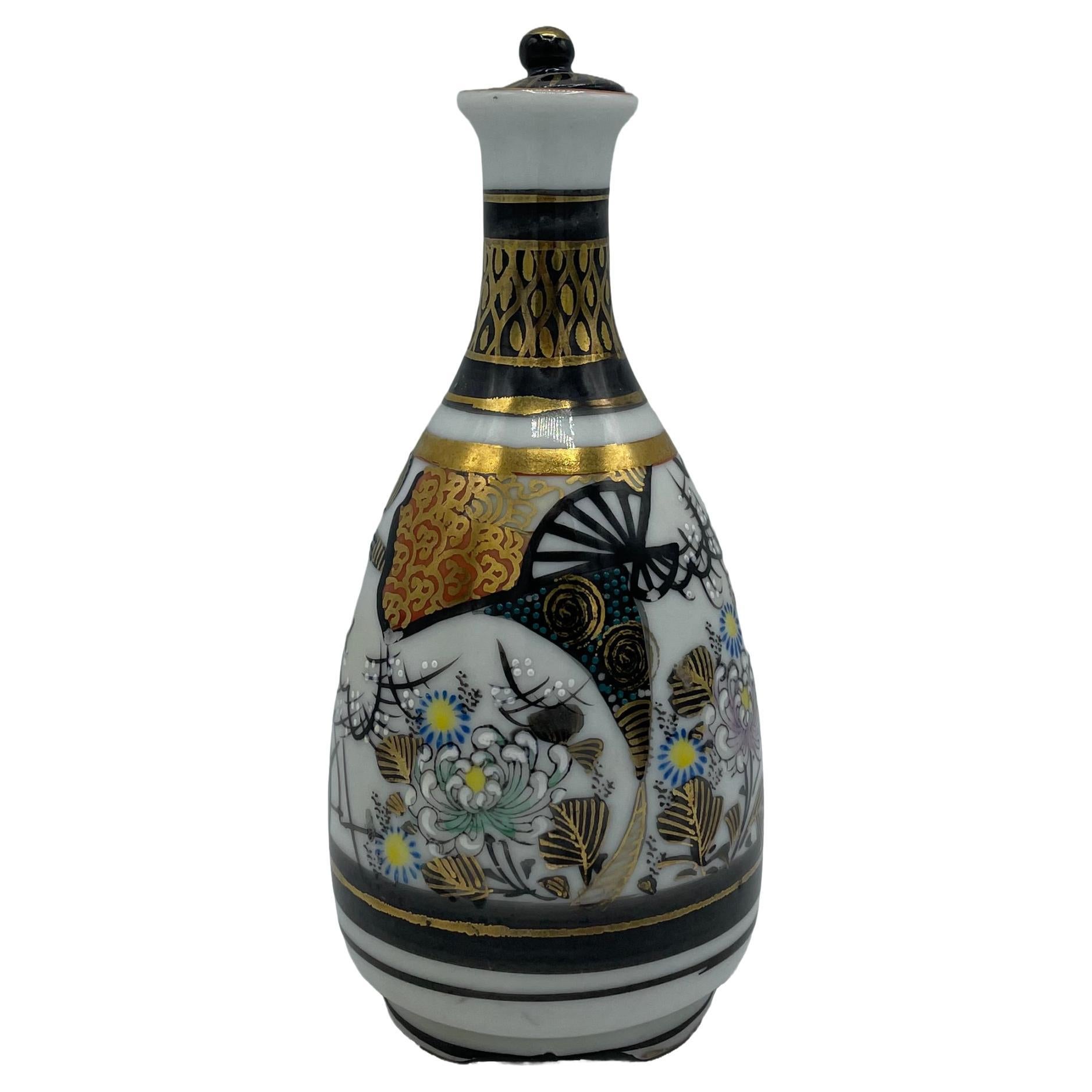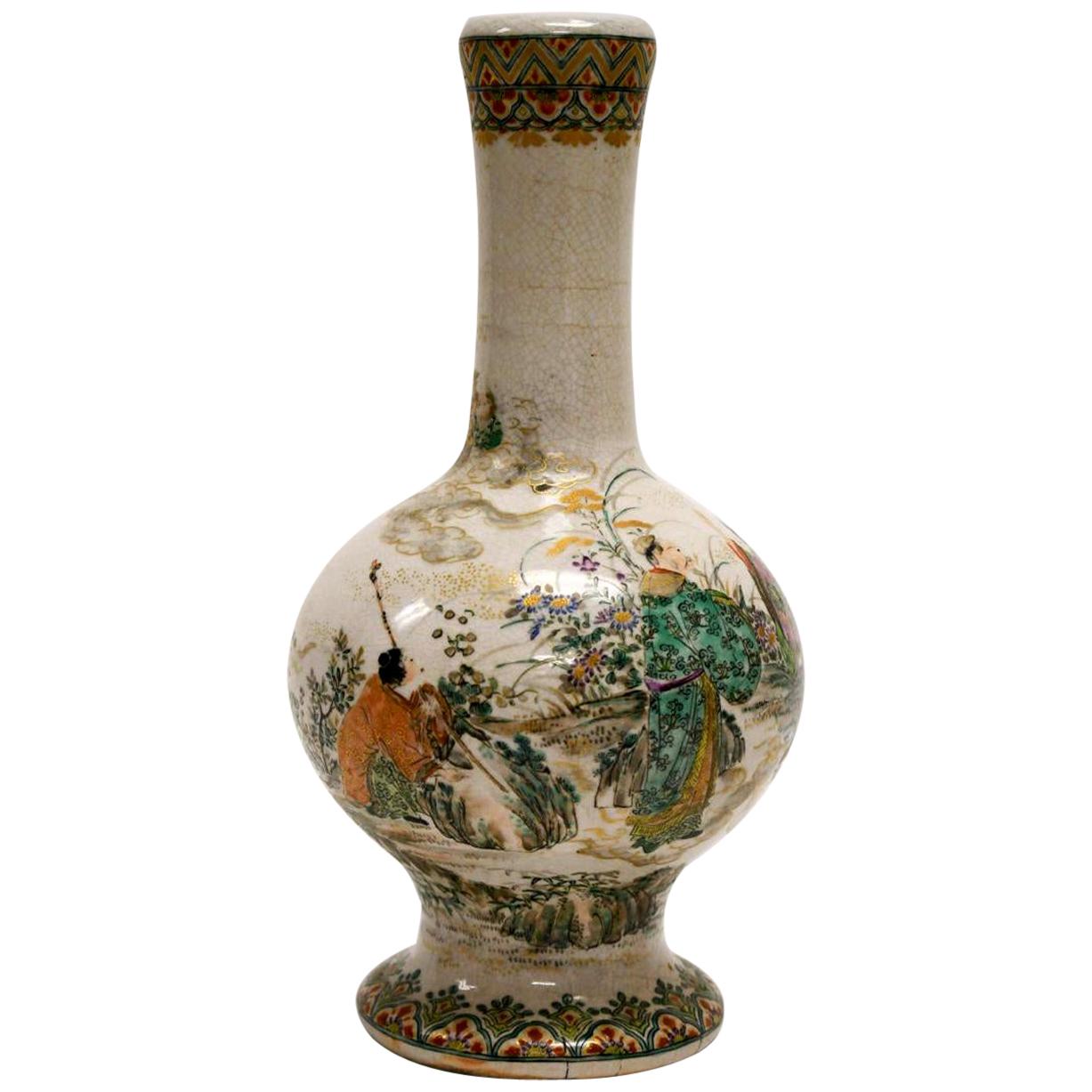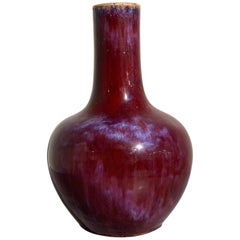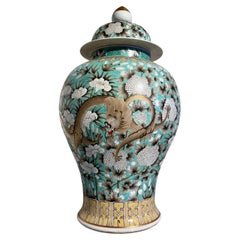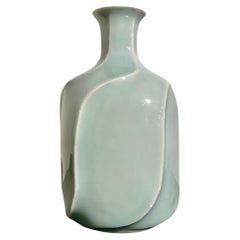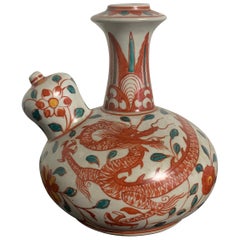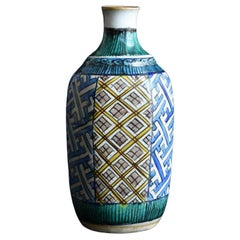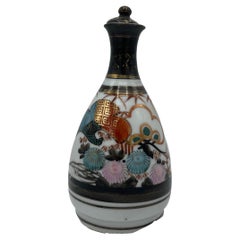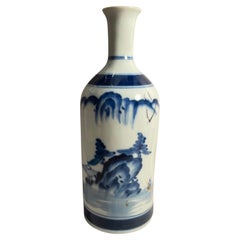Items Similar to Japanese Kutani Sake Bottle, Tokkuri, Yoshidaya Style, Edo Period, early 19th c
Want more images or videos?
Request additional images or videos from the seller
1 of 13
Japanese Kutani Sake Bottle, Tokkuri, Yoshidaya Style, Edo Period, early 19th c
$1,200
£913.31
€1,056.09
CA$1,703.04
A$1,905.74
CHF 991.39
MX$22,962.75
NOK 12,481.13
SEK 11,792.59
DKK 7,883.17
About the Item
A bold and dramatic Japanese Kutani porcelain square tokkuri (bottle for sake), decorated in the Yoshidaya style, and attributed to the Yoshidaya Kiln (1824 - 1831).
The striking sake bottle is decorated with overglaze enamels in the aote color palette of yellow, green, blue, and purple. Square in shape, the bottle has a slight taper, faceted shoulders, and a short, narrow tapered neck with a slightly everted mouth.
The tokkuri is decorated with charming scenes of geese to one side, pine branches to the opposite side. The other two sides decorated with mulberry leaves and the full moon(?) against a yellow diaper patterned ground. The shoulders decorated with cartouches featuring large carp swimming above the waves.
The underside with a single "Fuku" mark in black against a yellow ground cartouche, one of the hallmarks of the Yoshidaya kilns.
- Attributed to:Yoshidaya (Workshop/Studio)
- Dimensions:Height: 8.75 in (22.23 cm)Width: 4.5 in (11.43 cm)Depth: 4.5 in (11.43 cm)
- Style:Edo (Of the Period)
- Materials and Techniques:
- Place of Origin:
- Period:
- Date of Manufacture:1824 - 1831
- Condition:Wear consistent with age and use. No chips, cracks, or repairs noted. The enamels still vibrant. One small scratch to one of the full moons, as seen in photos.
- Seller Location:Austin, TX
- Reference Number:1stDibs: LU894746205122
About the Seller
5.0
Gold Seller
Premium sellers maintaining a 4.3+ rating and 24-hour response times
Established in 2001
1stDibs seller since 2010
346 sales on 1stDibs
Typical response time: 1 hour
- ShippingRetrieving quote...Shipping from: Austin, TX
- Return Policy
Authenticity Guarantee
In the unlikely event there’s an issue with an item’s authenticity, contact us within 1 year for a full refund. DetailsMoney-Back Guarantee
If your item is not as described, is damaged in transit, or does not arrive, contact us within 7 days for a full refund. Details24-Hour Cancellation
You have a 24-hour grace period in which to reconsider your purchase, with no questions asked.Vetted Professional Sellers
Our world-class sellers must adhere to strict standards for service and quality, maintaining the integrity of our listings.Price-Match Guarantee
If you find that a seller listed the same item for a lower price elsewhere, we’ll match it.Trusted Global Delivery
Our best-in-class carrier network provides specialized shipping options worldwide, including custom delivery.More From This Seller
View AllChinese Qing Dynasty Flambé Glazed Bottle Vase, Tianqiuping, Late 19th Century
Located in Austin, TX
A gorgeous Chinese monochrome red flambé glazed bottle vase, called a tianqiuping, Qing Dynasty, late 19th century.
The voluptuous body o...
Category
Antique Late 19th Century Chinese Qing Vases
Materials
Porcelain
Large Chinese Dayazhai Style Temple Jar and Cover, Mid 20th Century, China
Located in Austin, TX
A large and impressive vintage Chinese turquoise ground and grisaille decorated Dayazhai style porcelain temple jar and cover, with a four character "Yongqing Changchun" mark in iron...
Category
Mid-20th Century Chinese Qing Ceramics
Materials
Enamel
Miyanaga Tozan III Seihakuji Glazed Tokkuri, Showa Era, Japan
Located in Austin, TX
A sublime and elegant seihakuji (qingbai or celadon) glazed porcelain tokkuri (sake bottle) by Miyanaga Tozan III, also known as Miyanaga Rikichi, (b. 1935), Showa Period, circa 1980...
Category
Vintage 1980s Japanese Showa Ceramics
Materials
Porcelain
Chinese Export Kendi, Swatow Ware, Porcelain with Polychrome Enamels, circa 1900
Located in Austin, TX
A delightful Swatow ware Chinese export shipwreck porcelain kendi featuring a writing dragon and an apocryphal Tongzhi mark, late 19th or early 20th centur...
Category
Antique Early 1900s Chinese Qing Ceramics
Materials
Porcelain
Japanese Imari Baluster Vase, Meiji Period, Late 19th Century, Japan
Located in Austin, TX
A lovely tall Japanese Imari porcelain baluster vase with images of Chinese boys, Meiji Period, late 19th century, Japan.
The tall vase of baluster form, with a short, slightly spla...
Category
Antique Late 19th Century Japanese Meiji Vases
Materials
Porcelain
Large Japanese Satsuma Covered Vase, Showa Period, Mid 20th Century, Japan
Located in Austin, TX
A very large and exuberantly decorated Japanese Satsuma millefleur covered vase, marked Satsuma, Showa period, mid 20th century, Japan.
The large vase of attractive baluster form, with a slightly splayed foot, narrow waist, and tapered body with high shoulders and short neck. The vase topped by a domed cover with a large finial shaped like a hoju, the wish fulfilling jewel.
The vase decorated all over in a dense field of flowering blossoms - peony, lotus, and chrysanthemum - in a design known as millefleur, or a thousand flowers. The flowers freely and cheerfully painted in various colors of red, white, orange, green, blue and yellow, with raised white enamels...
Category
Mid-20th Century Japanese Showa Ceramics
Materials
Stoneware
You May Also Like
Japanese Colorful Antique Sake Bottle / 'Kutani Ware' / 1830-1900 / Small Vase
Located in Sammu-shi, Chiba
Kutani ware is a color-painted porcelain produced around Kanazawa City in the southern part of Ishikawa Prefecture, starting in 1655. It features a colorfu...
Category
Antique 19th Century Japanese Edo Vases
Materials
Pottery
Japanese Porcelain Kutani Sake Bottle with Lid 1970s
Located in Paris, FR
This is a sake bottle which is called 'tokkuri' in Japanese.
This tokkuri is made with porcelain and it is hand painted.
It was made in Showa era around 1970s.
The design is the land...
Category
Vintage 1970s Japanese Showa Porcelain
Materials
Porcelain
$226 Sale Price
20% Off
A Museum Quality Japanese Hirado bottle vase. Signed . Edo period
Located in London, GB
A Museum Quality Japanese Hirado bottle vase. Signed . Edo period
A Tall-Necked Hirado Vase
Edo - Meiji period (19th century)
Oviform with tall neck, ...
Category
Antique 19th Century Japanese Ceramics
Materials
Porcelain
Japanese Antique Sake Bottle 'Landscape' 1920s Taisho era
Located in Paris, FR
This is a Sake bottle made in Japan around 1920s. These kind of bottles are called Kayoi tokkuri. On this bottle, there are a drawing of a Japanese view.
It can be used as serving sa...
Category
Vintage 1920s Japanese Taisho Ceramics
Materials
Ceramic
Japanese Porcelain Sake Bottle 1970s Kutani Ware
Located in Paris, FR
This is a sake bottle which is called 'tokkuri' in Japanese.
This tokkuri is made with porcelain and it is hand painted.
It was made in Showa era around 1970s.
The design is the land...
Category
Late 20th Century Japanese Showa Pottery
Materials
Porcelain
$226 Sale Price
20% Off
Early Japanese Satsuma Antique Vase
By Satsuma
Located in Atlanta, GA
An Satsuma ceramic stone ware vase, circa 19th century, around the end of the Edo and the beginning of Meiji period. In the form of a Classic garlic bottle whose prototype was from China, the white bodied piece is decorated with an early form of kin nishikide, the so called golden brocade, a palette of iron-red, blue, green, yellow, purple and black with golden highlight. The over glazed enamel paint shows a group of robed figures in a garden setting with a lion and three tigers. A transparent overall glaze shows very fine crackles. The design is relatively sparse with plenty of negative space in contrast to the Satsuma production from the late 19th century, when the trend became fussy and overly glitz, due to the influence by the perceived western taste for the export market. This piece may still be made for export but its pattern was more influenced by both Kyoto Pottery and the Kano school of painting compared to the export ware by the end of the 19th century onward to the early 20th century. It was believed by many that this was a result of Satsuma potters visiting Kyoto in the late seventeenth century to learn over glaze painting techniques.
There are some age glaze crackles especially around the foot. The piece is not signed in keeping with the earlier production before Satsuma ceramics...
Category
Antique Mid-19th Century Japanese Japonisme Ceramics
Materials
Ceramic
$2,850 Sale Price
25% Off
